Transform Your Space with Whole Wall Curtains
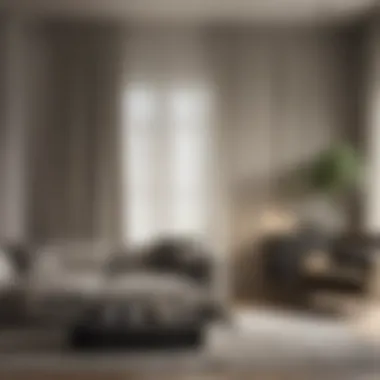
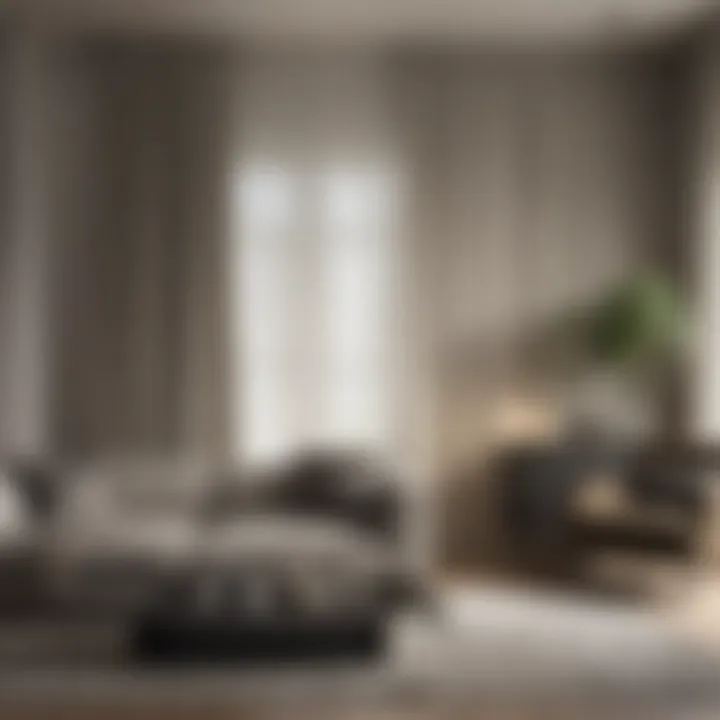
Intro
Whole wall curtains represent a significant trend in the realm of interior design. They offer a unique blend of aesthetics and functionality that can alter the way a space feels and functions. By covering entire walls, these curtains create a seamless and dramatic effect, transforming ordinary rooms into sophisticated and inviting environments.
The concept of using whole wall curtains extends beyond mere decoration. They play an essential role in enhancing energy efficiency, which is increasingly relevant in today’s eco-conscious society. Choosing the right fabric and installation method can lead to both improved insulation and reduced energy costs. This article will explore various aspects of whole wall curtains, including their installation process, fabric types, and maintenance requirements.
Additionally, we will look at current trends, popular color palettes, and practical tips for homeowners and designers. The goal is to provide a comprehensive understanding of how whole wall curtains can be integrated into various design schemes to create cohesive and appealing living spaces.
Prologue to Whole Wall Curtains
Whole wall curtains are not merely fabric hanging on a rod; they represent a significant trend in contemporary interior design. Their importance stems from their dual ability to enhance the aesthetic appeal of a space while providing essential functional benefits. As more homeowners and designers seek to create environments that blend beauty with practicality, whole wall curtains have become a vital element in achieving these goals. This section examines the dimensions of whole wall curtains, offering insights into their unique characteristics and value in transforming spaces.
Defining Whole Wall Curtains
Whole wall curtains are designed to cover an entire wall rather than just framing a window. Generally, they can incorporate large panels that extend from the ceiling to the floor, creating a seamless effect. This design choice serves multiple purposes. It can visually enlarge a room, drawing the eye upward and making spaces appear more expansive. Additionally, these curtains can provide privacy, light control, and insulation, making them practical for various residential and commercial environments. The choice of fabric, color, and pattern greatly influences the atmosphere created by these curtains, hence requiring careful consideration.
Historical Context and Evolution
The use of fabric to cover walls and windows is not a recent phenomenon. Historically, heavy drapes were a sign of wealth and sophistication, often used in grand halls and noble estates. Over time, the styles and materials have evolved significantly. By the mid-20th century, lighter fabrics became popular as modern design began to favor minimalism and functionality. The advent of synthetic materials also played a role in the evolution of whole wall curtains, allowing for innovations in durability and maintenance. Today, whole wall curtains reflect a blend of tradition and contemporary utility, adapting to personal style preferences and environmental awareness. Their evolution highlights how design trends are responding to changing societal needs and aesthetic values.
Aesthetic Considerations
The role of aesthetic considerations cannot be overstated when discussing whole wall curtains. These elements significantly influence the overall look and feel of a space. Homeowners and designers often view curtains as mere functional items. However, they hold the power to transform rooms into visually appealing environments.
Whole wall curtains do more than merely cover windows. They can create a sense of harmony and cohesion throughout a room. The choice of fabric, color, and texture can either blend seamlessly with existing decor or stand out as artistic statements. This section explores the importance of aesthetic elements in whole wall curtains, focusing on enhancing visual appeal, creating focal points, and employing color schemes and patterns that are both functional and stylish.
Enhancing Visual Appeal
Whole wall curtains possess an understated elegance that can elevate a room’s visual appeal. The sheer volume of fabric often adds texture that is lacking in other elements of interior design. When draped from ceiling to floor, they draw the eye upward, which can make a space feel larger than it is.
- Texture Matters: Fabrics such as linen, silk, or velvet can bring depth and character to a room.
- Layering Options: Using multiple layers of curtains can help create depth and complexity. Sheer layers combined with heavier drapes enhances richness.
- Proportions: Balance fabric size with room proportions to avoid feelings of overwhelm. This is especially true in smaller spaces where light fabrics can keep an airy feel.
Creating a Focal Point
A well-placed whole wall curtain can act as an eye-catching focal point in a room. Instead of simply framing windows, they can encompass an entire wall to direct attention toward a specific area. For example, using a bold color or an intricate pattern creates interest, leading the eye to center around that element. This is particularly effective in open floor plans where navigation between spaces might be confusing.
"Whole wall curtains can enhance the design scheme and serve as a point of visual interest."
- Strategic Placement: Position curtains to emphasize architectural features like fireplaces or artwork, while adding character.
- Personal Expression: Creating a unique style through curtains allows homeowners to showcase their personality.
Color Schemes and Patterns
Colors and patterns are essential in determining overall aesthetics. The right choice can either harmonize with or contrast against existing decor. With whole wall curtains, the possibilities are vast.
- Monochromatic Schemes: Utilizing shades of one color can create a serene and cohesive look.
- Contrasting Colors: Opting for contrasting hues can evoke energy, making the space feel dynamic and inviting.
- Patterns: Geometric, floral, or abstract prints can introduce visual excitement. Patterns can be profound or subtle based on preferences.
In summary, aesthetic considerations play a crucial role in integrating whole wall curtains into interior design. The visual appeal, creation of focal points, and thoughtful color and pattern selection all contribute to how the space is experienced. Approaching these elements with intention helps to achieve a more cohesive and inviting atmosphere.
Functional Advantages
Whole wall curtains serve a multifaceted role in interior design that transcends mere aesthetics. Understanding the functional advantages of these curtains is essential for homeowners and design enthusiasts alike. Their ability to influence light intake, improve energy efficiency, and provide acoustic benefits cannot be overstated. Each of these aspects contributes significantly to overall comfort and style in residential spaces, making them valuable tools in modern design.
Light Control and Privacy
One of the primary functional advantages of whole wall curtains is their ability to regulate light. Depending on the fabric and design chosen, these curtains can filter, diffuse, or block direct sunlight. Fabrics like sheer linen or light cotton allow natural light to flow through while softening its intensity. Conversely, heavier fabrics such as velvet or blackout curtains can create a complete barrier against outside light, which is particularly useful for bedrooms and home theaters.
Privacy is another critical consideration. Whole wall curtains can easily be closed to prevent outside viewing, allowing residents to enjoy their spaces without concern about prying eyes. This feature is particularly beneficial in urban environments where homes are closely situated.
Insulation and Energy Efficiency
Insulation is an often-overlooked advantage of whole wall curtains. Thick or thermal-lined curtains can enhance a home's ability to retain heat during winter months while keeping spaces cool in the summer. This thermal resistance allows homeowners to potentially lower their heating and cooling bills.
Additionally, using energy-efficient materials can make these curtains even more effective. Many products are available that incorporate sustainable fabrics designed specifically to improve energy efficiency. This not only benefits the homeowner economically but also contributes positively to environmental sustainability.
Sound Absorption
Sound absorption is a valid concern, especially in open-concept spaces or in homes located near busy streets. Whole wall curtains can play an important role in dampening noise. Heavier fabrics tend to absorb sound, reducing reverberation and creating a quieter indoor environment.
Properly chosen and strategically installed, these curtains can effectively minimize sound transmission from both inside and outside. This functionality makes them suitable for various applications, including home offices or study areas, where concentration is necessary.
"Whole wall curtains offer more than just a stylish design element; they provide essential functionalities that enhance the comfort and practicality of living spaces."
In summary, the functional advantages of whole wall curtains—light control, energy efficiency, and sound absorption—play a crucial role in interior design. They contribute to the living experience, making spaces not only more pleasant but also more functional.
Materials and Fabric Selection
In the realm of interior design, the choice of materials and fabrics plays an essential role in achieving the desired look and functionality of whole wall curtains. The right selection can greatly influence how a space feels and performs. Different fabrics have unique qualities, such as texture, durability, and light-filtering capabilities. This section will delve into two crucial aspects: choosing the right fabric and the sustainable options available today.
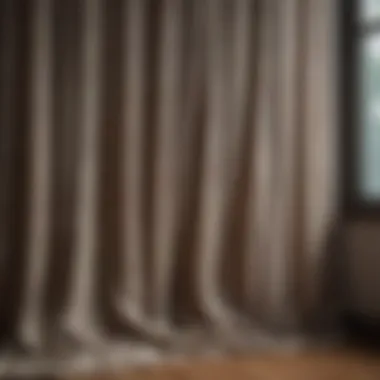
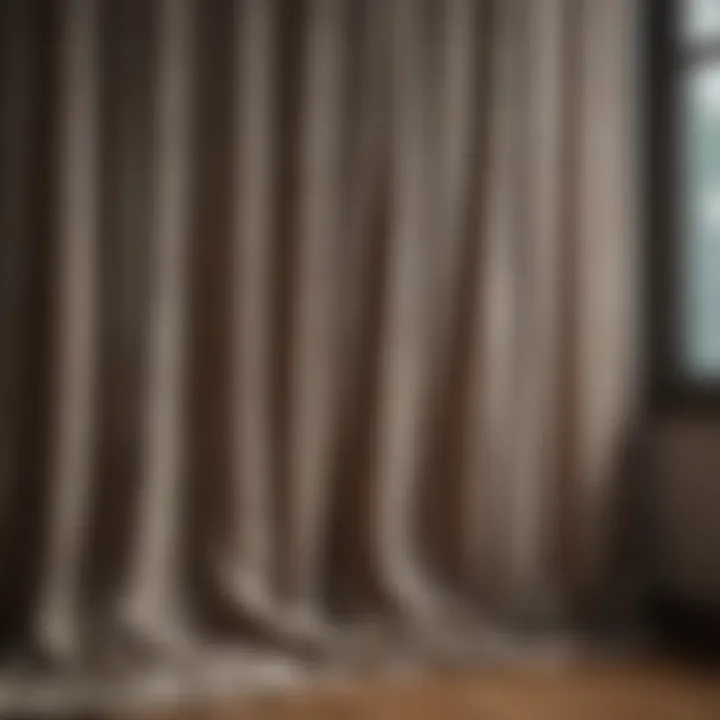
Choosing the Right Fabric
Selecting the appropriate fabric for whole wall curtains is vital for both aesthetic appeal and practical use. Homeowners need to consider several factors when choosing fabric:
- Purpose: Are the curtains meant to provide privacy, light control, or simply decoration? Heavy fabrics like velvet may be more suitable for formal spaces, whereas lightweight sheers can enhance casual environments.
- Style: The fabric's color, pattern, and texture should complement the existing decor. For example, a bright color can energize a room, while neutral tones can create a tranquil ambiance.
- Maintenance: It is crucial to consider how easy the fabric is to clean. Some materials, like polyester, resist stains and wrinkles, making them practical choices for high-traffic areas.
Potential fabric options include:
- Cotton: Breathable and versatile; suitable for casual settings.
- Linen: Offers a natural look but can wrinkle easily.
- Silk: Luxurious and elegant, though it may require more care.
- Polyester: Durable and often less expensive, available in various styles and weaves.
"The right fabric can not only enhance the functionality of your curtains but also elevate the overall look of your space."
Sustainability in Material Choices
As sustainability becomes a focal point for many homeowners and designers, the choice of fabric must also reflect eco-conscious values. Sustainable materials help reduce environmental impact while maintaining high aesthetic and functional standards. Some aspects to consider include:
- Natural Fibers: Fabrics such as organic cotton, hemp, and linen are biodegradable and typically produced with less harmful processes.
- Recycled Materials: Choosing curtains made from recycled polyester or other repurposed materials reduces waste and can offer high performance.
- Local Sourcing: Selecting fabrics from local manufacturers can reduce transportation emissions and support local economies.
When opting for sustainable materials, be aware of certifications like Global Organic Textile Standard (GOTS) or OEKO-TEX, which can guide in making responsible choices.
Installation Techniques
Installation techniques play a critical role in the effectiveness and overall appearance of whole wall curtains. Understanding how to properly install these curtains can greatly enhance the desired aesthetic and ensure they function as intended. These curtains are more than just decorative elements; they offer several practical benefits, which can only be fully realized through correct installation.
The choice of installation method can influence other aspects as well, such as light control, privacy, and insulation. For example, a well-installed curtain rod can provide ease of use and enhance the look of the fabric selected. This section will explore the dual approach of installing whole wall curtains, focusing on both DIY methods and when to consider professional assistance.
DIY Installation Tips
Installing whole wall curtains on your own can be a fulfilling task that adds a personal touch to your space. Here are some practical tips to guide DIY enthusiasts:
- Measure Accurately: Before purchasing curtains, measure the wall area meticulously. Consider the length and width to ensure the fabric drapes correctly. Use a tape measure and record your measurements for reference.
- Selecting the Right Hardware: Choose appropriate curtain rods or tracks that fit the style and weight of your curtains. For heavier fabrics, stronger rods or brackets may be necessary.
- Wall Anchors: If you’re mounting curtains on drywall, use wall anchors to support the weight. This can prevent the rods from sagging or pulling away from the wall.
- Follow Instructions: Each installation kit comes with specific guidelines. Read through the instructions carefully to avoid common installation mistakes.
- Use a Level: Ensure your curtain rod is level before securing it to the wall. A small error can lead to an uneven appearance once the curtains are hung.
"Proper installation enhances both the functionality and beauty of whole wall curtains. It makes the difference between a professional finish and a haphazard look."
Professional Installation Considerations
While DIY can be rewarding, sometimes hiring a professional for installation is the best option. Here are aspects to evaluate when considering professional help:
- Expertise: Professionals bring experience and skills that can ensure your installation is seamless. They can also troubleshoot complex situations that an average homeowner may not anticipate.
- Time Efficiency: Hiring someone allows you to save time. Instead of wrestling with tools and measuring, a professional can complete the job quickly and effectively.
- Advanced Techniques: Some window treatments may require specific techniques that are best left to experts. This can include custom measurements for unique window shapes or specialized mounting hardware.
- Warranty and Guarantee: Many professional services offer warranties on their installation work. This can provide peace of mind in case of any issues down the line.
In summary, whether opting for a DIY approach or seeking professional expertise, proper installation techniques for whole wall curtains are key to maximizing their potential benefits in your space.
Maintenance and Care
Whole wall curtains represent not just a style choice but also a significant investment in your home’s interior. Therefore, maintenance and care for these installations is essential to prolong their functionality and aesthetic appeal. Regular attention to cleaning and upkeep can significantly enhance the visual impact of the curtains, ensuring that they continue to contribute positively to the overall design of your space.
Cleaning Techniques
Keeping whole wall curtains clean is crucial to maintaining their beauty. Dust, dirt, and allergens can accumulate over time, dulling the fabric and detracting from its appearance. Here are some effective cleaning techniques:
- Vacuuming: Use a vacuum cleaner with a soft brush attachment to gently remove dust and debris. This process should be done at least once a week to prevent buildup.
- Spot Cleaning: For minor stains, a damp cloth with a mild detergent can be used. Gently dab the area rather than rubbing, as this can spread the stain or damage the fabric.
- Machine Washing: If the fabric is machine washable, follow the care instructions carefully. Use a gentle cycle and cold water, and avoid using bleach as it can fade colors.
- Professional Cleaning: For delicate fabrics or significant soiling, consider professional cleaning services. They have the expertise and equipment to clean without damaging your curtains.
Longevity and Durability
Durability is an important aspect when considering whole wall curtains. High-quality materials will ensure longevity, but proper maintenance will further enhance their lifespan. Here are several strategies to improve durability:
- Quality Fabric Selection: Choose fabrics known for their resilience, such as polyester blends or treated linens. These materials often withstand wear and tear better than their more delicate counterparts.
- Avoid Direct Sunlight: Prolonged exposure to direct sunlight can fade colors and weaken fibers. Use UV-filtering window films or rotate the curtains occasionally to avoid uneven fading.
- Regular Inspections: Periodically check the curtains for signs of wear. Look for fraying edges or loose seams. Addressing minor issues quickly can prevent them from escalating into major repairs.
- Proper Storage: If you need to take down the curtains, store them properly. Keep them in a dry, dust-free place, and avoid folding them tightly to prevent creases.
"Regular maintenance not only keeps your curtains looking fresh but also enhances their durability, ensuring your investment lasts longer than expected."
By understanding and implementing these maintenance techniques, you will ensure that your whole wall curtains not only enhance the beauty of your space but also provide lasting functionality. A well-cared-for curtain system reflects your commitment to quality design and thoughtful living.
Trends in Whole Wall Curtains
Understanding the latest trends in whole wall curtains is essential for homeowners and designers looking to innovate their spaces. As interior design continues to evolve, whole wall curtains adapt to not just aesthetics but also broader lifestyle considerations. The integration of these curtains is influenced by various factors such as practicality, sustainability, and the pursuit of comfort. It is important to explore these trends to stay informed on how these elements can enhance living areas and contribute to an overall design strategy.
Contemporary Designs
Contemporary designs of whole wall curtains reflect a shift towards minimalism and functionality. Homeowners are increasingly favoring clean lines and understated elegance in their spaces. Fabrics such as sheer linens, natural fibers, or tailored blackout options are becoming popular choices. These materials offer not only style but also practical advantages in terms of light control and insulation.
Additionally, geometric patterns and bold colors are gaining traction. They serve as statements within a room, adding depth without overwhelming. The versatility of contemporary designs means they can adapt to various styles, from modern to rustic or eclectic.
The role of technology cannot be overlooked. Smart curtains that can be automated or controlled via smartphone are becoming more prevalent. This convenience aligns with the lifestyle of many homeowners seeking efficiency and ease in their living environments.
Cultural Influences
Cultural influences play a significant role in shaping trends in whole wall curtains. As globalization brings diverse design ideas into the mainstream, homeowners are exposed to a multitude of styles. For instance, Scandinavian designs focus on simplicity and natural beauty, favoring light, airy curtains that enhance the feel of openness in spaces. Similarly, Japanese aesthetics emphasize minimalism and craftsmanship, often incorporating soft textures and muted tones.
Each cultural style brings its own set of implications regarding fabric choice, color palettes, and overall ambience. Homeowners may find themselves drawn to these influences, seeking to incorporate elements that resonate with their identity or travel experiences. Ultimately, wide-ranging cultural inspirations lead to a richer, more varied approach to curtain design.
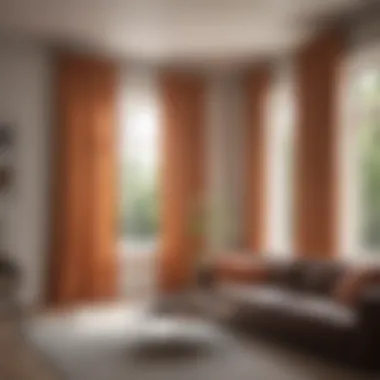
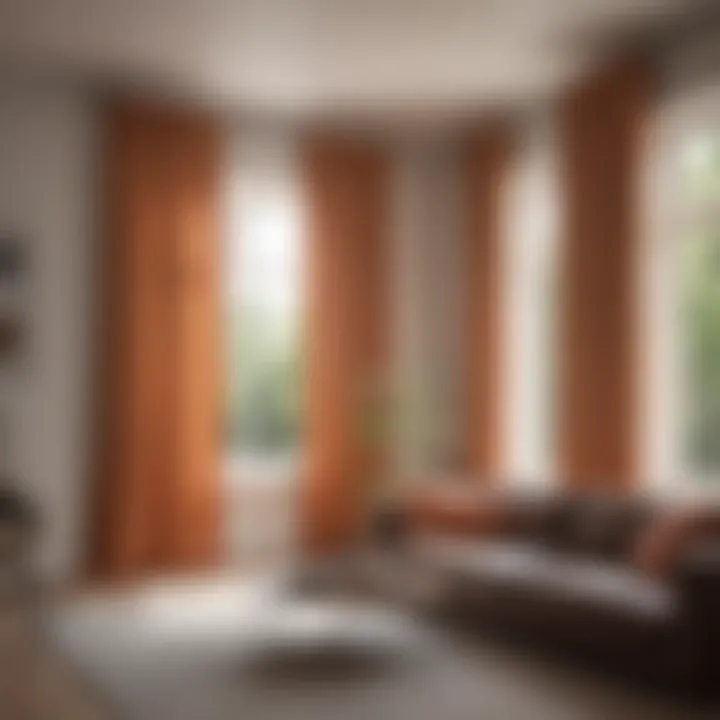
"Trends in whole wall curtains are more than mere fashion statements; they reflect the evolving tastes and needs of contemporary living spaces."
Applications in Various Spaces
The integration of whole wall curtains into various spaces offers significant opportunities and improvements that can elevate the overall aesthetic and functionality of a room. Different spaces have unique requirements and characteristics, necessitating tailored solutions that accommodate specific activities and ambiances. The proper application of whole wall curtains can enhance the use of space, support privacy needs, and contribute to energy efficiency, while also providing an elegant touch to any environment.
Living Room Innovations
In living rooms, whole wall curtains can act as a transformative element. They provide a way to create a cozy and inviting atmosphere while promoting versatility in decor. For example, opting for lighter fabric choices can help maximize natural light during daytime, contributing positivity to the environment. In contrast, heavier materials can provide intimacy during evening hours, creating a comfortable space for relaxation or social gatherings.
Here are a few considerations for using whole wall curtains in the living room:
- Color Selection: Choose colors that complement existing furniture and decor. Neutral tones often work well but don’t shy away from bold colors if they align with the intended design theme.
- Length and Coverage: Floor-to-ceiling curtains can give the illusion of higher ceilings and a more expansive feel.
- Layering Options: Consider using sheers behind heavier drapes. This allows for flexible light filtering without sacrificing privacy.
By innovatively integrating whole wall curtains, homeowners can elevate their living areas, making them both functional and aesthetically pleasing.
Bedroom Solutions
In bedrooms, whole wall curtains serve multiple crucial roles. They allow control over light, which is essential for creating an ideal sleeping environment. Apart from light control, these curtains can enhance privacy, ensuring a serene retreat from the outside world.
Key aspects to consider in bedrooms include:
- Material Choice: Blackout fabrics can completely shield out light, facilitating restful sleep. Alternatively, lighter materials can create a soft ambiance that promotes relaxation.
- Temperature Regulation: Thermal curtains can contribute to energy efficiency by helping to maintain room temperature, leading to lower heating and cooling costs.
- Styling Techniques: Utilizing patterned curtains or combining different textures can turn simple window coverings into a focal point, adding depth to the room's design.
With the right approach, whole wall curtains can effectively enhance the comfort and style of bedrooms, serving as a crucial element of the overall design.
Office Integration
In office spaces, whole wall curtains facilitate a blend of professionalism and comfort. They can define work areas, reduce distractions, and enhance privacy for meetings and focused work sessions.
Several practical benefits include:
- Improved Focus: Adjustable curtains allow individuals to control the amount of natural light, helping to reduce glare on screens and improve concentration.
- Sound Absorption: The right fabric can dampen noise levels, which is particularly valuable in open-plan offices.
- Design Cohesiveness: Customize curtains to align with corporate branding or color themes, creating a unified and professional environment.
Incorporating whole wall curtains into office design not only boosts function but also enhances the overall work atmosphere, making it more conducive to productivity.
By strategically applying whole wall curtains in various settings, one can accentuate both the aesthetics and functionality of each space.
Psychological Impact of Window Treatments
The psychological effects of interior design choices extend far beyond mere aesthetics. Window treatments, particularly whole wall curtains, play a significant role in shaping our emotional responses to spaces. In this section, we will explore how these curtains influence perceptions of space and openness, as well as how they impact mood and atmosphere in various environments.
Sense of Space and Openness
Whole wall curtains can dramatically alter the perception of a room's size. When drawn back, these expansive fabric panels reveal natural light, creating a sense of openness and airiness. This can make a space feel less confined and more inviting. Studies suggest that exposure to natural light can boost serotonin levels, which in turn elevates mood.
Moreover, the use of light, sheer fabrics can enhance this effect, adding to the visual continuity between indoor and outdoor spaces. When choosing whole wall curtains, consider materials that allow sunlight to filter through while maintaining a level of privacy. This balance is crucial for making any space feel larger and more connected to the outside world.
The choice of window treatments can significantly influence how occupants feel within a space, affecting everything from productivity to relaxation levels.
Impact on Mood and Atmosphere
The relationship between our environment and emotions is well documented. Whole wall curtains can either enhance or detract from the atmosphere of a room based on color, texture, and style. For instance, darker, heavier fabrics may evoke feelings of warmth and coziness, while lighter colors can feel refreshing and energizing.
When curating the mood of a space, it is essential to consider not only the color palette but also how the curtains interact with other elements of the room. Textured fabrics can add depth and interest, while smooth materials contribute to a more minimalistic and modern aesthetic. It's essential to experiment with various styles to find what resonates most with your emotional well-being.
In summary, understanding the psychological impact of whole wall curtains can aid homeowners and interior design enthusiasts in making informed decisions that enhance their living environments. Choosing the right treatments will not only beautify a space but also contribute positively to the mood and overall atmosphere.
Economics of Whole Wall Curtains
When considering interior design, aesthetics often take center stage, but the economic aspects cannot be overlooked. Whole wall curtains are not just a design element; they also represent a financial investment that can yield significant returns. Understanding the economics of whole wall curtains is crucial for homeowners and designers alike, as it informs decisions that affect both budget and value of living spaces.
Cost Analysis
Cost is a primary factor in any home improvement project. The initial outlay for whole wall curtains can vary widely depending on materials, size, and brand selections. Generally, high-quality fabrics can range from $20 to $100 per yard. However, there are cheaper options available, although they may compromise durability and aesthetic appeal.
In terms of hardware, installation costs may vary. A DIY approach can reduce expenses considerably. Professional installation is an alternative but often adds significantly to the total cost. Depending on the complexity of the job, fees can reach $200 to $500.
Moreover, maintenance and cleaning costs should not be ignored. Fabrics like polyester tend to be easier to maintain compared to silk or linen, which may require special handling. While the upfront costs can be daunting, the importance of long-term value and functionality should not be underestimated.
Return on Investment
The return on investment (ROI) for whole wall curtains can be substantial when looking at both practical and aesthetic benefits. Homeowners often find that improved energy efficiency translates into lower utility bills. For example, curtains that provide insulation can help maintain stable indoor temperatures, cutting heating and cooling costs.
Aesthetic value is also a significant contributor to ROI. Well-chosen whole wall curtains enhance a room's overall appearance, potentially increasing property value. A stylish and cohesive look can attract buyers, enhancing marketability.
Additionally, the versatility of whole wall curtains means they can evolve with changing design trends, offering longevity in style and function. As the market shifts towards open space designs, these curtains can effectively delineate different areas while maintaining an elegant flow.
"Investing in whole wall curtains offers not only immediate aesthetic improvements but also long-term savings through energy efficiency and potential increases in property value."
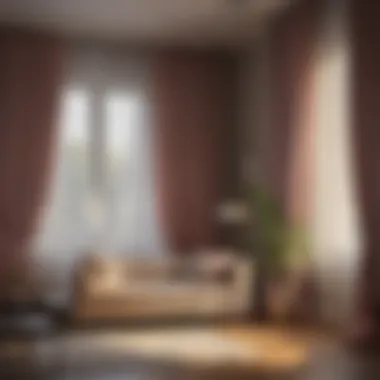
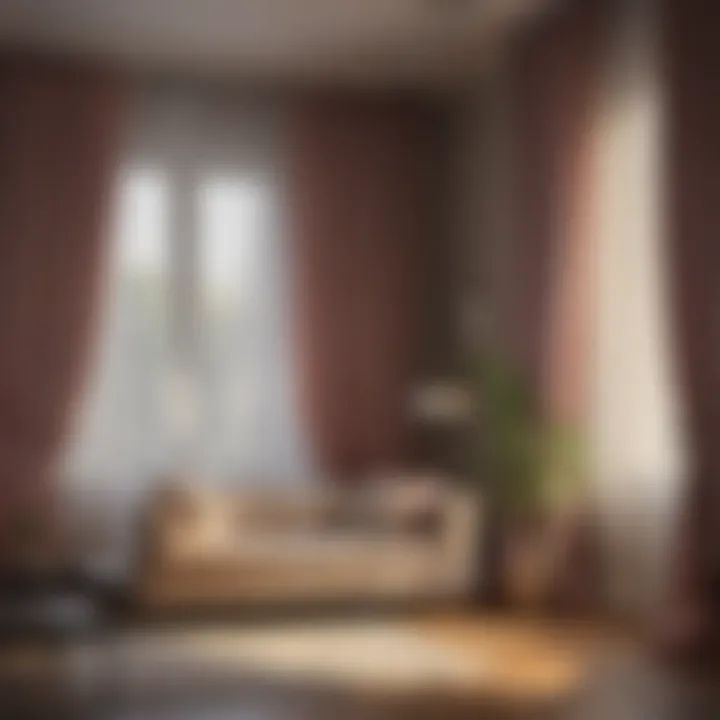
In summary, the economics of whole wall curtains underscores their dual role as both a stylish element and a wise financial investment. Their capability to enhance living spaces combined with economic advantages makes them a notable choice for those looking to improve both function and design.
Comparing Whole Wall Curtains to Traditional Drapes
The decision to use whole wall curtains versus traditional drapes is more than a matter of personal preference. It reflects deeper considerations of functionality, aesthetics, and overall interior design philosophy. Whole wall curtains offer distinct advantages that can significantly alter the ambiance of a space. In this section, we unravel the specific elements and benefits tied to each option, helping homeowners and design enthusiasts make informed decisions.
Functional Differences
When examining the functional aspects, whole wall curtains and traditional drapes serve similar purposes but with notable distinctions. Whole wall curtains effectively cover larger areas, often reaching from floor to ceiling. This can enhance light control and privacy by minimizing gaps where unwanted light enters. Traditional drapes, however, usually cover only part of a window, leading to inconsistencies in light blocking.
Additionally, whole wall curtains can offer better insulation. They span entire walls, which may help regulate temperature more efficiently than traditional drapes. This is particularly beneficial for homeowners looking to improve energy efficiency. Flexibility is another advantage. Whole wall curtains can be drawn completely to one side, providing an unobstructed view when desired. Conversely, traditional drapes may create a blockage that disrupts the flow of natural light.
"Functional choices in window treatments can make or break the overall utility of a space."
Aesthetic Comparisons
Aesthetically, whole wall curtains provide a modern and seamless look that can transform the entire room. Their wide fabric draping creates a cascading effect that adds a sense of grandeur. This can enhance verticality in small rooms, making the space appear taller and more open.
In contrast, traditional drapes may contribute to a more segmented appearance. They often draw focus to the window alone rather than the wall as a whole. The fabrics and patterns available for whole wall curtains can often integrate better with contemporary design trends, allowing for bold choices that can unify color schemes across a room. Traditional drapes, on the other hand, may reflect vintage styles, catering to more classic aesthetics that not all modern homes embrace.
Case Studies and Success Stories
Case studies and success stories serve a critical function in showcasing the tangible benefits and transformative outcomes attributed to whole wall curtains. They reveal how these design elements have revolutionized spaces for both residential and commercial purposes. By examining real-world examples, potential users can gain insights into how they might integrate whole wall curtains into their own environments. Moreover, these stories provide validation of whole wall curtains' effectiveness as a modern design solution.
In the realm of interior design, these narratives can influence decisions by illustrating practical applications that enhance aesthetics, functionality, and overall ambiance. They help to demystify the process of installation and the impact different fabric choices can make. It is essential to explore the diverse outcomes that these curtains can achieve, offering a roadmap for a successful transformation.
Residential Transformations
In residential contexts, whole wall curtains have been employed to create impactful visual changes that reflect personal style and improve the utility of a home. One notable example can be observed in a small urban apartment that faced challenges with limited natural light. The homeowner introduced sheer whole wall curtains that not only allowed light to filter through but also provided privacy without sacrificing openness. This decision transformed the living space into a brighter and more inviting area, making it feel significantly larger than it actually was.
Additionally, in a spacious family home, heavier drapery was chosen to create a more dramatic and cozy atmosphere in the living room. The whole wall curtain design executed with a rich, deep color complemented the existing decor and acted as a statement piece. This residential transformation demonstrated how whole wall curtains can be both functional and a focal point, catering to the unique needs of different spaces.
Commercial Applications
In commercial environments, whole wall curtains can redefine aesthetics and functionality in various ways. For instance, a boutique hotel utilized whole wall curtains to enhance guest rooms. The fabrics selected were lightweight but also provided sound absorption, ensuring that noise from outside was kept at bay. Guests reported improved sleep quality, attributing this comfort to the combination of the curtains and the room design.
Another example involves a corporate office that aimed to promote a more relaxed atmosphere. Using whole wall curtains in strategic areas created areas for privacy while maintaining an open feel. The design not only enhanced employee satisfaction but also improved the overall aesthetic of the workspace. By incorporating whole wall curtains, businesses can create versatile environments that cater to different needs throughout the day.
In summary, case studies illustrate how impactful whole wall curtains can be in various settings, demonstrating their versatility and adaptability. The insights gained from these transformations can guide homeowners and designers to make informed choices.
Challenges and Limitations
Understanding the challenges and limitations associated with whole wall curtains is crucial for anyone considering their implementation. While these curtains can bring beauty and functionality, not every space is suitable for them. Homeowners and interior designers must recognize specific constraints that could affect the effectiveness and usability of whole wall curtains.
Space Constraints
When dealing with whole wall curtains, space constraints are a major consideration. The visual impact of these curtains can be considerable, and they may overwhelm smaller rooms. In tight spaces, the extensive fabric can create a feeling of confinement rather than openness.
This issue is especially relevant in urban settings where real estate often comes at a premium. Placing whole wall curtains in small apartments, for instance, can make a space feel cramped. Instead, opt for lighter materials or multi-functional designs that can complement the existing decor without overpowering it.
"Size matters. In smaller spaces, less can be more when it comes to window treatments."
Homeowners should also assess their furniture layout before committing to whole wall curtains. If sofas or chairs already block near-wall spaces, adding further fabric could reduce movement or flow. In such cases, accessories like blinds or smaller panels may provide a better solution without sacrificing style.
Maintenance Challenges
Maintenance is another area that poses challenges for whole wall curtains. Their size can complicate regular cleaning processes. Unlike standard drapes, which can easily be taken down and washed, whole wall curtains may require specialized cleaning methods due to their sheer dimensions.
The choice of fabric can play a significant role here. Natural materials like cotton and linen often need more care and may not withstand frequent washing. Synthetic options, while durable, can present their own problems. They may be more likely to accumulate dust and need to be vacuumed or spot-cleaned regularly.
Additionally, the positioning of these curtains often makes them more susceptible to wear and tear. This factor becomes particularly critical in high-traffic areas or near windows that face direct sunlight, which causes fading and deterioration over time.
Homeowners should be proactive in cleaning and care. Regular dusting can help maintain their appearance. Furthermore, a proper understanding of the fabric's specific needs will extend its lifespan. Overall, while whole wall curtains offer much, the commitment to maintenance cannot be overlooked.
Ending
The conclusion of this article is vital as it encapsulates the significant insights garnered throughout the discussion on whole wall curtains. This section asserts not only the aesthetic appeal of these curtains but also their functional benefits, providing a holistic perspective on their role in interior design.
Summarizing Key Insights
Whole wall curtains have emerged as an influential element in modern interior design. They create a seamless flow between spaces and enhance the overall ambiance. Here are the key insights:
- Versatility: Whole wall curtains are adaptable to various styles, from minimalist to opulent, allowing for personal expression.
- Energy Efficiency: They significantly contribute to thermal insulation, helping maintain comfortable indoor temperatures and eventually lowering energy costs.
- Sound Absorption: The fabric used in these curtains aids in reducing noise levels, turning any environment into a sanctuary.
- Enhanced Privacy and Light Control: Homeowners can easily manage natural light and maintain privacy, creating a balanced and comfortable atmosphere.
"Whole wall curtains are not just decorative; they redefine functionality and comfort in our living spaces."
The importance of these insights lies in their ability to guide homeowners and designers in making informed choices when selecting and utilizing whole wall curtains.
Future Perspectives on Design Trends
Looking forward, trends surrounding whole wall curtains continue to evolve. Here are a few anticipated developments:
- Sustainable Materials: As awareness around sustainability grows, the demand for eco-friendly fabrics will likely rise. Designers will focus on using organic fibers and sustainable production methods.
- Smart Integration: The integration of technology into home design is gaining traction. Expect innovations in automatic curtain systems that respond to light or temperature changes.
- Bold Patterns and Colors: While neutral tones have dominated recently, there will be a shift towards bolder designs, offering homeowners the ability to make striking statements.
- Mixed Materials: The blend of different fabrics and materials within whole wall curtains to create depth and interest will become increasingly popular, catering to various design preferences.
As whole wall curtains continue to gain traction in both residential and commercial environments, their impact on interior design will undoubtedly expand, making it essential for consumers to stay informed about emerging trends and technologies.















